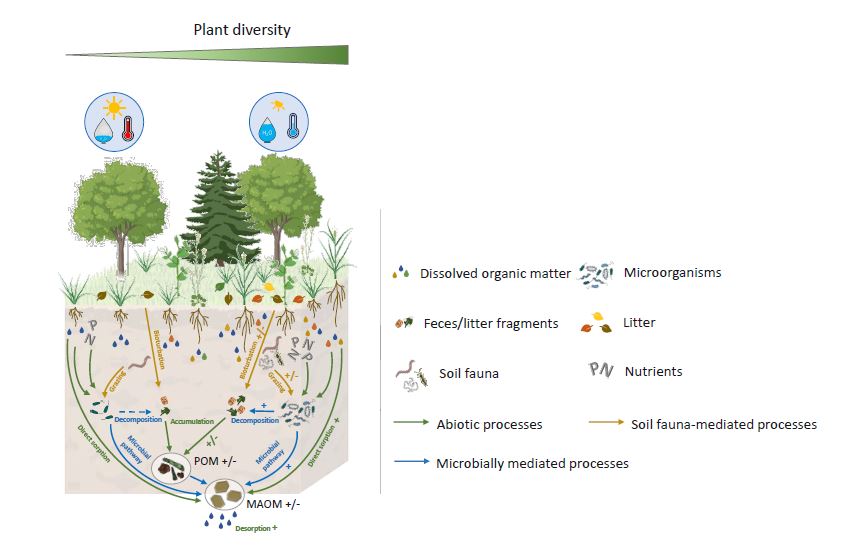Report by Dr Gerrit Angst, former Walter-Benjamin Fellow at the Experimental Interaction Ecology group at iDiv, Leipzig University, now group leader at the Czech Academy of Sciences
Exploring how plant diversity affects the persistence of soil organic matter helps understand and predict responses of soil carbon sequestration to biodiversity losses or gains across ecosystems. This is the conclusion of our review paper – written in collaboration with colleagues from the German Centre for Integrative Biodiversity Research (iDiv), Leipzig University, Cleveland State University, the Max-Planck Institute for Biogeochemistry, and the Czech Academy of Sciences. We provide an overview of links between plant diversity and soil organic matter persistence and highlight environmental contexts that strengthen or weaken these links, with implications for overall carbon storage in soil. The study has recently been published in Nature Communications.
Carbon stored in soil is sensitive to changes in plant diversity. Restoration or enhancement of plant diversity could thus increase soil carbon storage and help mitigate climate change. However, studies report mixed results: plant diversity sometimes has strong, slight, or hardly any effect on soil carbon storage. We argue that these inconsistencies can be explained by how plant diversity affects the persistence of soil carbon in varying environmental contexts.
Where persistent pools of carbon are closer to “saturation” (e.g., in some grasslands or mature forests), increases in soil carbon can mostly be achieved via less persistent carbon pools. In such contexts, plant-diversity effects on persistent pools of soil carbon are less relevant or can even decrease these pools. This results in lower positive net effects of plant diversity on total soil carbon storage.
In contrast, ecosystems in which soils are far from carbon saturation and in which carbon storage is mainly limited by plant inputs (such as in many agricultural soils or deeper soil layers), plant diversity can increase both persistent and less persistent pools of carbon and has thus the largest net positive effect on total soil carbon.
Viewing and testing plant-diversity effects on soil carbon storage and persistence in light of this context-specificity will help predict changes in soil carbon upon biodiversity loss or gain and inform biodiversity-related management strategies.
Original publication
(Researchers with iDiv affiliation and alumni bolded)
Šárka Angst, Gerrit Angst, Kevin E. Mueller, Markus Lange, Nico Eisenhauer (2025). Un(der)explored links between plant diversity and particulate and mineral-associated organic matter in soil. Nature Communications, DOI: 10.1038/s41467-025-60712-6
Contact
Dr Gerrit Angst
Alumnus of the German Centre for Integrative Biodiversity Research (iDiv) Halle-Jena-Leipzig
Head of Soil Biochemistry
Czech Academy of Sciences
E-mail: gerrit.angst@bc.cas.cz
